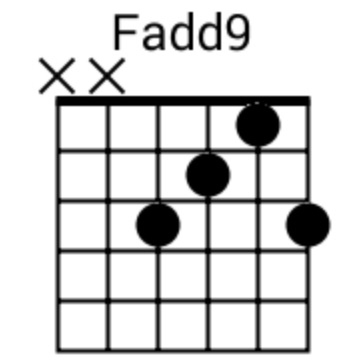Yesterday’s Bonus Round: “Walkin’ Back To Georgia” is a song written and performed by the late Jim Croce. It appears on his 1972 album “You Don’t Mess Around With Jim”.
Yesterday we introduced “suspended” chords and we talked a bit about how a guitarist can use some suspended chords to create a little melodic riff “around” the basic chord. What I’ve found is that technique is most useful on the high e, B and G strings, but your mileage may vary. Definitely a good topic for discussion with your guitar instructor. It takes a lot of practice to get the timing right so you get the sound you’re looking for. The technique can be described as a quick hammer on/pull off, but it’s not quite that either. My guitar instructor describes it as a “dawdle”, and as the name (which may be his own descriptor, or maybe an obscure term known only to guitar wizards, which he certainly is!) implies it has a lot to do with timing. It’s not just changing a note, it’s more a way to capture the sliding tone while a note transitions from the previous note as the string is released and depressed. This is way more complicated to write about than it is to do. Here’s a great example- this is the live acoustic version of Counting Crows song “Angels Of The Silences”. It is a very different sound from the album version which is heavily electric guitar. Listen at about 5-9 seconds into the intro and you’ll hear 3 or 4 bars repeated with a note that sort of slides up in pitch and then immediately descends. It’s momentary but adds a great deal of interest.
That’s a “dawdle”. You can hear it throughout the song in parts where the acoustic guitar comes to the “front”. More than a quick hammer on/pull off, it momentarily slurs the transition between notes.
I don’t do any “instructional” videos on Michael Acoustic, so this is a “demo” of me doing a warmup routine that includes a lot of hammer on/pull off/dawdles. It’s rough, as a warmup can be, I didn’t pay much attention to fret buzz and dead strings and awkward chord changes, but you may get a flavor of how I do some dawdles/hammer ons/pull offs to add interest to chords. Also, I’m not playing a song or even in “a” key, just chords across several keys. A rough progression, just so you can kinda see where I’m at (camera angle is a bit difficult):
DMaj Dsus2 Dsus4
Am Asus2 Asus4 (this may sound familiar - it’s one of the progressions in the Kansas song “Dust In The Wind”)
Dm Dmsus4 Dmsus2
GMaj Gsus4
CMaj CMaj7 Cadd9
Am A7
F FMaj7 Fadd9 (this is my cheatin’way of playing F) and F#4add9 (I’m not sure if this is even a real chord as played - you just lift your index finger from the C [1st fret] on the B string - sounds kinda cool - see note below)
Em Em7
AMaj AMaj7
After that I kinda just started jamming and lost track - that’s how my warmups tend to go.
Note on the FMajadd9:
This is how I “cheatplay” an FMaj if I don’t want to barre (and I usually don’t). It’s a quicker chord change and also gives me the advantage of lifting my little finger playing the G (the add9 note) to play an FMaj7 and also lifting my index finger playing the C on the B string, which gives me that sorta F#4add9 - which should properly be called an Faug4add9, since the 4th is a “perfect” interval, so I’m kinda using musical slang here - meh. Note this results in a “wicked” F-B tritone, a somewhat discordant, but interesting interval. In medieval times that particular interval was shunned as being so dissonant that it was called the “devil’s interval”.
As always, this isn’t instruction, it’s a topic to discuss with your guitar instructor. I was fortunate to have a great one, along with a great instructor in music theory at a local college. Find the best and stick with them.
I wanted to finish up by talking a little more about the “imposter syndrome” concept that’s gained some media attention. In the past we might have described it as “stage fright” or anxiety about publicly putting yourself out there in musical performance. It’s fair to say most musicians feel all of those things to some degree, but I acknowledge the idea of imposter syndrome as a different, if related phenomena. My personal take (and only mine - imposter syndrome is a real thing, and may need professional therapy - I don’t want to minimize that at all!) is I’m sort of an “honest imposter” - I recognize I am a middling guitarist at best, and a middling at best vocalist. I’m a reasonably good songwriter, and I’m pretty happy with that combination. I’m also a fairly good writer, which I attribute to education and various careers in my background. Am I great? Nope. Do I care? Also nope. My typos and corrections to Michael Acoustic aggravate me, but meh. We’re doing pretty well with increasing engagement (THANK YOU ALL!!!!), so I’m not going to beat myself up too badly. There’s no advice here, I’m not in the least qualified for that. I will say I’m just barely unperturbed enough about what people think of me to be somewhat bold, and my hide does get thicker as I grow older. Your mileage may vary. I will add, supportive friends and bandmates help a lot. Creative people can and often do have differences. Work through them with as much kindness and patience as you can, and learn as much as possible.
One place that’s helped many over the last couple of years is the Acapella app - I’ve mentioned it before, but it bears repeating. It’s a place to be part of a virtual, and often differing group of musicians. I’ve found everyone there to be kind and supportive of one another. Here’s an example:
This is me playing and singing the great Townes Van Zandt song (though I’m definitely channeling Willie’s version here). I would have been apprehensive to have just put it out there. But I knew I had friends that would support me. Here’s the final version:
Sure helps to have friends!! Leave a note in the comments if you want to hear the funny story behind the hat and sunglasses!!
No links today, but some good advice from Mr. Griff Hamlin at Blues Guitar Unleashed:
“How slow is too slow when you're practicing something new (like counting out loud?)
The simple answer... it's not possible to go too slow.
Time after time I watch students just like you try to play new things or try to count out loud for the first time or any one of a dozen different things...
... and get so frustrated simply by trying to go too fast.
Beats and musical time goes by in small, even pieces... much like seconds on a clock.
If you simply count each step as it goes by, and don't be afraid to really stop on each step and think about what needs to happen and either execute or not, as required... you'll get it down.
And at the end of the day, you'll make a lot more progress in much less time...
... even though it might seem a lot more tedious at first.”
It might even seem like you're going "so slow" that there's no way you could possibly ever go fast enough...
But trust me on this one, you can (and probably should) start slower and let the speed build when the time is right.
Talk soon,
Griff”
Bonus Round: A classic from the master himself!!
Cheers, and keep playing!!
Michael Acoustic





